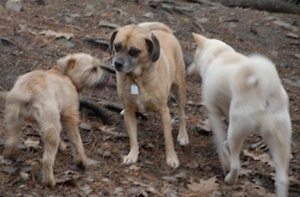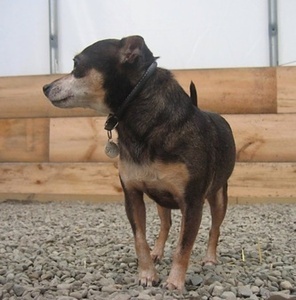When you approach your dog in a head on or direct manner, does he turn his head away? If so, it’s not that he’s trying to ignore you. It’s quite the opposite. He’s talking to you and would quite appreciate an action on your part to clarify your harmless intentions.
Head turns can vary. Dogs may offer repeated head turns from side to side, might turn their head and hold it turned away, or can will only slightly turn away while being sure to also avert any eye contact.
Dogs meet one another in what might seem like an avoidant manner and do not walk straight up to one another. As polite dogs approach each another, you will see some head turning at first greeting. To us humans, it may look as though they are ignoring each other or are distracted by something else. They are not. They are simply talking their own language.
See the photo below where Ziggy is approached by two dogs at once. She is offering a head turn. Notice though that each dog is mindful of approaching Ziggy at her side. Ziggy would certainly appreciate a head turn from the Shiba Inu (right) here to diffuse the intensity of the greeting.
“I’m calm. Are you calm?”

In the photo below, where would you think the dog’s might focus their attention? Perhaps the man that’s running straight towards them? Well, they ARE aware and focused on that man. They are all offering head turns away as he runs straight toward them.
If you walk up to your dog to put his leash on and you lean over, does he turn his head?
What about the camera? Often times, people will pull out a camera and their dog will look the other way while it points directly in their face, unless a kissy noise or high pitched sound is used to elicit some attention and a head tilt.
I love the shot below. Sammy (aka Spammy for his love of food) turned his head away while being approached with the camera every time! Sammy is not constantly distracted; rather he is talking to us. We had to get some photos of him for his parents while they were on vacation, but were also mindful of making sure our photo shoots didn’t infringe too much on his own vacation here with us. Clearly, Sammy finds the limelight a bit much.

So, how can you talk back? If you’d like to help your dog to understand your harmless and loving intentions, you can also offer a head turn, sigh, or yawn in response. Just like us, dogs lob out their words/signals hoping to have a conversation, where the other participant responds. Offering this sigh, yawn or head turn will let your dog know that you are calm and friendly.
The video below shows a well-loved dog who is clearly trying to calm down his owner. He keeps his head turned away most of the time during her well intentioned, but overbearing attempt to have some quality time. Notice when she finally turns away (talks back!), the dog offers a stretch (another calming mechanism) and switches positions. And since, we’ve already covered it on DogSpeak, did you see the whale eye too in this video?
One of the main goals in teaching DogSpeak is to help pet parents to develop a better understanding of how our dogs interpret our actions. Most owners are very well intentioned, but miscommunication still occurs, often during training and obedience lessons. If your dog offers a head turn during training sessions or when asked to do something; he is not ignoring you. Rather he is simply letting you know that the training goal is possibly a bit complex, maybe the tone in which you are asking is a bit intense, or possibly you are using a physical prompt (such as pushing on your dog’s tushie for a sit, giving a collar correction for a non response, etc.).
Please know that your dog is not ignoring you or being disobedient. He is trying to tell you that he’s a bit stressed, confused, or wondering why you are! Switching your tone of voice, the way your body is positioned, or not using physical prompts in your training can all help.
Looking for more ways to better understand and communicate with your dog? Check out all of Colleen’s DogSpeak columns…